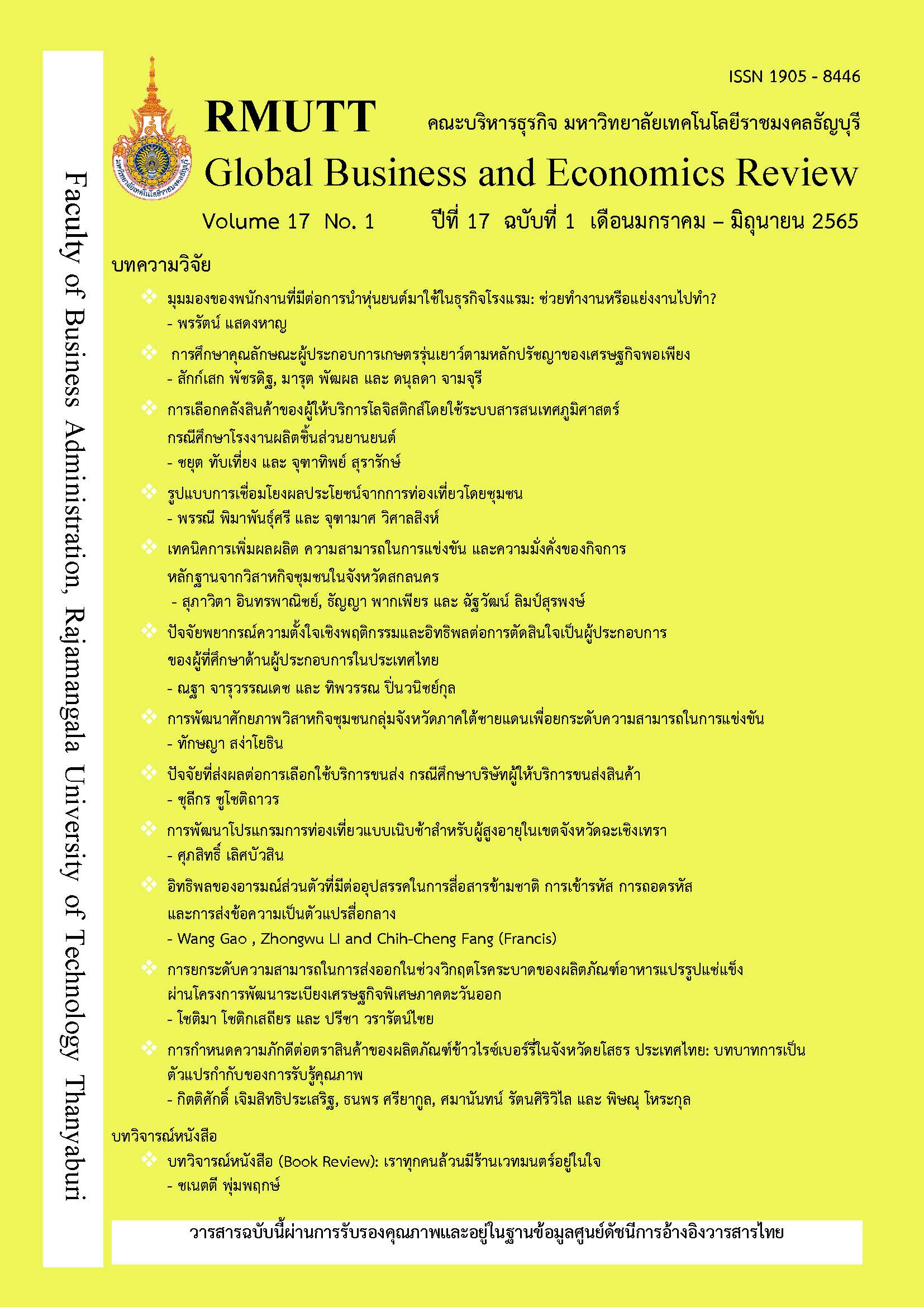การยกระดับความสามารถในการส่งออกในช่วงวิกฤตโรคระบาดของผลิตภัณฑ์อาหารแปรรูปแช่แข็งผ่านโครงการพัฒนาระเบียงเศรษฐกิจพิเศษภาคตะวันออก
คำสำคัญ:
ความสามารถการส่งออก , วิกฤตโรคระบาด , อาหารแปรรูปแช่แข็งบทคัดย่อ
การยกระดับความสามารถในการส่งออกของผลิตภัณฑ์อาหารแปรรูปแช่แข็งในช่วงวิกฤตโรคระบาด จากการจัดการความเสี่ยง บนโซ่คุณค่า และความได้เปรียบทางการแข่งขัน เป็นแนวคิดที่เพิ่มประสิทธิภาพการส่งออก โดยเฉพาะในเขตโครงการพัฒนาระเบียงเศรษฐกิจพิเศษภาคตะวันออก ซึ่งมีสถานประกอบการอย่างหนาแน่น การวิจัยครั้งนี้มีวัตถุประสงค์เพื่อศึกษา 1) อิทธิพลของโซ่มูลค่าที่ส่งผลต่อประสิทธิภาพในการส่งออกของอาหารแปรรูปแช่แข็งผ่านโครงการพัฒนาระเบียงเศรษฐกิจพิเศษภาคตะวันออก 2) อิทธิพลของโซ่มูลค่าที่ส่งผลต่อประสิทธิภาพในการส่งออกของอาหารแปรรูปแช่แข็งผ่านโครงการพัฒนาระเบียงเศรษฐกิจพิเศษภาคตะวันออกโดยมีความได้เปรียบในการแข่งขันเป็นตัวแปรคั่นกลาง 3) อิทธิพลของความเสี่ยงที่ส่งผลต่อประสิทธิภาพในการส่งออกผลิตภัณฑ์อาหารแปรรูปแช่แข็งผ่านโครงการพัฒนาระเบียงเศรษฐกิจพิเศษภาคตะวันออก และ 4) อิทธิพลของความเสี่ยงที่ส่งผลต่อประสิทธิภาพในการส่งออกผลิตภัณฑ์อาหารแปรรูปแช่แข็งผ่านโครงการพัฒนาระเบียงเศรษฐกิจพิเศษภาคตะวันออกโดยมีความได้เปรียบในการแข่งขันเป็นตัวแปรคั่นกลาง การวิจัยครั้งนี้เป็นการวิจัยเชิงปริมาณ มีกลุ่มตัวอย่าง คือ ผู้ประกอบการอาหารแปรรูปแช่แข็ง จำนวน 400 บริษัท ใช้การสุ่มตัวอย่างแบบหลายขั้นตอน ขนาดของกลุ่มอย่างใช้เกณฑ์ 20 เท่า ของตัวแปรสังเกตได้ เก็บรวบรวมข้อมูลแบบสอบถาม และวิเคราะห์ข้อมูลด้วยแบบจำลองสมการโครงสร้าง ผลการวิจัยพบว่า 1) โซ่มูลค่ามีอิทธิพลทางตรงเชิงบวกต่อความได้เปรียบในการแข่งขันอย่างมีนัยสำคัญทางสถิติที่ระดับ .001 2) โซ่คุณค่ามีอิทธิพลทางอ้ออมต่อประสิทธิภาพในการส่งออกผลิตภัณฑ์อาหารแปรรูปแช่แข็งผ่านความได้เปรียบในการแข่งขันอย่างมีนัยสำคัญทางสถิติที่ระดับ .05 3) การจัดการความเสี่ยงมีอิทธิพลทางตรงเชิงบวกต่อประสิทธิภาพในการส่งออกผลิตภัณฑ์อาหารแปรรูปแช่แข็ง อย่างมีนัยสำคัญทางสถิติที่ระดับ .001 และ 4) การจัดการความเสี่ยงมีอิทธิพลทางอ้อมเชิงบวกต่อประสิทธิภาพในการส่งออกผลิตภัณฑ์อาหารแปรรูปแช่แข็งโดยมีความได้เปรียบในการแข่งขันเป็นตัวแปรคั่นกลาง อย่างมีนัยสำคัญทางสถิติที่ระดับ .05 ผลการวิจัยครั้งนี้ สามารถเป็นแนวทางในการกำหนดนโยบายหน่วยงานที่เกี่ยวข้องทั้งภาครัฐและเอกชน รวมทั้งนำไปปรับใช้กลยุทธ์การจัดการความเสี่ยง ผ่านโซ่คุณค่า และความได้เปรียบทางการแข่งขัน เพื่อยกระดับการส่งออกของธุรกิจอาหารแปรรูปแช่แข็งภายในประเทศ
References
Barney, J. B. (1991). Firm resources and sustained competitive advantage. Journal of Management, 17(1), 99-120.
De Waal, A., Orij, R., Rosman, J., & Zevenbergen, M. (2014). Applicability of the high-performance organization framework in the diamond industry value chain. Journal of Strategy and Management, 7(1), 30-48.
Dyer, J. H., & Singh, H. (1998). The relational view: Cooperative strategy and sources of interorganizational competitive advantage. Academy of management review, 23(4), 660-679.
Escandon-Barbosa, D., Urbano-Pulido, D., & Hurtado-Ayala, A. (2019). Exploring the relationship between formal and informal institutions, social capital, and entrepreneurial activity in developing and developed countries. Sustainability, 11(2), 1-20.
Hair, J. F., Anderson, R. E., Tatham, R. C., & Black, W. C. (1995). Multivariate data analysis, with readings. Englewood Cliffs, NJ: Prentice Hall.
Imran, M., Aziz, A., Hamid, S. N. B. A., Shabbir, M., Salman, R., & Jian, Z. (2018). Retracted: The mediating role of total quality management between entrepreneurial orientation And SMEs export performance. Management Science Letters, 8(6), 519-532.
Khamsuk, K. (2018). A Study of Factors Affecting Risks in Supply Chains of Thai Automotive Industry. Business Review Journal, 10(2), 123-142.
Kiser, J., & Cantrell, G. (2006). Six Steps to Managing Risk. Supply Chain Management Review, 10(3), 12-17.
Lambert, D. M., Stock, J.R., & Ellran, L. M. (1998). Supply chain and logistics management. New York: McGraw-Hill.
Lambert, D. M., & Enz, M. G. (2017). Issues in supply chain management: progress and potential. Industrial Marketing Management, 62, 1-16.
Lin, K. H., Huang, K. F., & Peng, Y. P. (2014). Impact of export market orientation on export performance. Baltic Journal of Management, 9(4), 403-425.
Martín de Castro, G., Navas López, J. E., López Sáez, P., & Alama‐Salazar, E. (2006). Organizational capital as competitive advantage of the firm. Journal of Intellectual Capital, 7(3), 324-337
Mei Dan, X., Ye, L., & Zhi Qiang, S. (2011). On the measure method of electronic supply chain risk. Procedia Engineering, 15, 4805-4813.
Monteiro, A. P., Soares, A. M., & Rua, O. L. (2019). Linking intangible resources and entrepreneurial orientation to export performance: The mediating effect of dynamic capabilities. Journal of Innovation & Knowledge, 4(3), 179-187.
Nation Broadcasting Corporation. (2563). Ministry of Commerce discusses private frozen seafood processing by turning COVID-19 into an opportunity. Retrieved from https://www.nationtv.tv/news/378772842
National Statistical Office. (2555). Selecting samples techniques. Workshop documents of the project for the Statistical Subcommittee of the National Statistical Office. Retrieved from http://service.nso.go.th/nso/nsopublish/Toneminute/files/55/0203-5.pdf
Niyangkoon, S. (2005). Research statistics. Bangkok: Kasetsart University.
Petchlum, K. (2019). Fresh, chilled, frozen, canned and processed seafood (excluding fresh, chilled, frozen and processed shrimp). Retrieved from https://www.ditp.go.th/contents_attach/539575/539575.pdf
Piercy, N. (2009). Positive management of marketing-operations relations. Journal of Marketing Management, 25(5-6), 551-570.
Porter, M. E. (1985). Competitive Strategy: Techniques for Analyzing Industries and Competitors. New York, NY: The Free Press.
Porter, M. E., & Miller, V. E. (1985). How information gives you competitive advantage. Harvard Business Review, 63(4), 149-60.
Saenyen, T., et al., (2020). Analysis of the COVID-19 responses: the impact on the aviation industry. Interdisciplinary Journal, Humanities and Social Sciences, 3(2), 209-220.
Suphan, W., et al. (2020). How to deal with COVID-19 in anesthesia?. Thai Journal of Anesthesiology, 46(3), 103–112.
Thun, J. H., & Hoenig, D. (2011). An empirical analysis of supply chain risk management in the German automotive industry. International journal of production economics, 131(1), 242-249.
Turakit, P. (2021). Frozen food exporters request compensation for tax compensation due to COVID-19 Test. Retrieved from https://www.prachachat.net/economy/news-590867
Varoutsa, E., & Scapens, R. W. (2015). The governance of inter organisational relationships during different supply chain maturity phases. Industrial Marketing Management, 46, 68-82.
Wang, M., Asian, S., Wood, L. C., & Wang, B. (2020). Logistics innovation capability and its impacts on the supply chain risks in the Industry 4.0 era. Modern Supply Chain Research and Applications, 2(2), 83–98.
Downloads
เผยแพร่แล้ว
How to Cite
ฉบับ
บท
License
Copyright (c) 2022 โชติมา โชติกเสถียร, ปรีชา วรารัตน์ไชย

This work is licensed under a Creative Commons Attribution-NonCommercial-NoDerivatives 4.0 International License.
บทความที่ได้รับการตีพิมพ์เป็นลิขสิทธิ์ของผู้นิพนธ์
ข้อความที่ปรากฏในบทความแต่ละเรื่องในวารสารวิชาการเล่มนี้เป็นความคิดเห็นส่วนตัวของผู้เขียนแต่ละท่านไม่เกี่ยวข้องกับมหาวิทยาลัยเทคโนโลยีราชมงคลธัญบุรี และคณาจารย์ท่านอื่นๆในมหาวิทยาลัยฯ แต่อย่างใด ความรับผิดชอบองค์ประกอบทั้งหมดของบทความแต่ละเรื่องเป็นของผู้เขียนแต่ละท่าน หากมีความผิดพลาดใดๆ ผู้เขียนแต่ละท่านจะรับผิดชอบบทความของตนเองแต่ผู้เดียว







